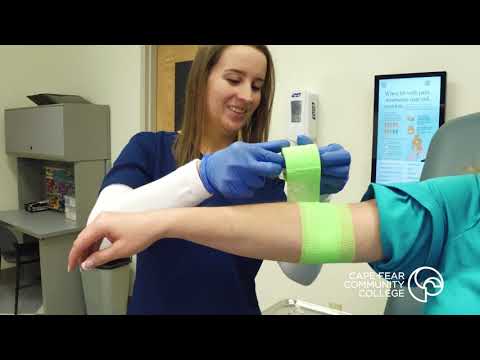Medical Assistant Education Requirements
Contents [show]
Medical assistants play a vital role in the healthcare industry. They provide support to doctors and nurses, and perform a variety of tasks to keep the medical facility running smoothly.
If you’re thinking of becoming a medical assistant you’ll need to know what the education requirements are. In this blog post, we’ll outline everything you need to know to get started in this rewarding career.
Checkout this video:
What are the educational requirements to become a medical assistant?
There are numerous ways to become a certified medical assistant (CMA). The most common path is to graduate from a postsecondary medical assisting program, which typically takes about one year to complete. Alternatively, some candidates may choose to earn a two-year associate degree in medical assisting. Some states also have certification programs that can take up to two years to complete.
In order to sit for the CMA exam, candidates must graduate from an accredited medical assisting program and have completed an externship of at least 160 hours. Once they pass the exam, CMAs are required to complete continuing education (CE) credits every few years in order to maintain their certification.
What type of training do Medical assistants need?
Medical assistants must have at least a high school diploma or equivalent, although many medical assistants have completed postsecondary education, such as a certificate or associate degree program in medical assisting. Employers typically prefer those candidates who have completed formal training programs.
Most medical assistants have postsecondary education such as a certificate, although some have associate degrees. Programs typically last from 1 to 2 years and include courses such as anatomy, physiology, Medical Terminology and other sciences along with general education classes. Many programs also include an externship, which allows students to gain on-the-job training under the supervision of a licensed healthcare professional.
What is the difference between a medical assistant and a medical secretary?
The difference between a medical assistant and a medical secretary is that a medical assistant is responsible for both clerical and clinical duties, while a medical secretary is responsible for only clerical duties. Medical assistants are trained to perform both administrative and clinical tasks in a medical office setting, while medical secretaries are only trained in administrative tasks. Both positions require the ability to type, file, and answer phones.
What are the duties of a medical assistant?
Medical assistants are multi-skilled health professionals specifically trained to work in outpatient facilities such as medical offices and clinics. Their duties vary with the location, specialty, and size of the practice. In small practices, medical assistants usually are responsible for many different clinical and administrative tasks, whereas in large practices they usually are assigned specific duties. Most medical assistants have postsecondary education such as a certificate, although some have specialized training and others have completed 2-year associate degree programs.
Most medical assistants are responsible for both clinical and administrative duties. However, their specific duties vary with the size and type of the practice and the state in which they work. The following list includes some common tasks for medical assistants:
Clinical duties:
• Take patient histories and record vital signs
• Help physicians examine and treat patients
• Prepare patients for examination
• Assist physicians with office surgical procedures
• Give injections
• Collect and prepare laboratory specimens
• Perform basic laboratory tests
• Instruct patients about medications and special diets
• Authorize prescription refills as directed by physician
• Handle correspondence
Administrative duties: • Schedule appointments • Arrange hospital admissions and laboratory services • Greet patients • Update and file patient medical records • Fill out insurance forms • Process insurance payments • Code patients’ Medical records for insurance purposes Many states have scope-of-practice laws that define the procedures that medical assistants are allowed to perform. These laws vary from state to state but usually allow medical assistants to perform routine clinical tasks under the supervision of a licensed healthcare provider.
What are the hours like for a medical assistant?
In general, medical assistants work full time, although some may work part time. Many medical assistants work in physicians’ offices, hospitals, or other healthcare facilities. Some travel with physicians or other healthcare professionals to provide care at the site of a medical emergency or outbreak, such as a natural disaster.
What is the job outlook for medical assistants?
The medical assistant occupation is projected to grow much faster than average for all occupations from 2018 to 2028. The number of medical assistant jobs is expected to increase by 29 percent during this ten-year period, adding about 184,500 new jobs. The aging Baby Boomer population will continue to need medical care, especially as they suffer from more chronic health conditions brought on by age. In addition, the demand for preventative medical services is expected to rise as people seek treatment for conditions before they become serious.
What is the salary for medical assistants?
According to the Bureau of Labor Statistics, the median wage for medical assistants in May 2018 was $33,610 per year. The lowest 10 percent earned less than $23,350, while the highest 10 percent earned more than $48,790.
What are the benefits of being a medical assistant?
There are many benefits to becoming a medical assistant. Perhaps the most obvious is that it is a career with a very clear path. Once you have completed your medical assistant education requirements, you will be able to find a job in a doctor’s office, hospital, or other healthcare facility.
In addition to the stability that comes with having a clear career path, medical assistants also enjoy good pay and good benefits. Medical assistants are often paid hourly, and they typically receive health insurance and other benefits from their employers.
Medical assistants also report high levels of job satisfaction. They often say that they enjoy helping others and that they feel like they are making a difference in the lives of their patients. If you are looking for a career that is both stable and fulfilling, then becoming a medical assistant may be the right choice for you.
What are the drawbacks of being a medical assistant?
There are a few drawbacks to being a medical assistant. One is that the job can be emotionally demanding. You may have to deal with sick and injured patients on a daily basis, and see firsthand the effects of their illnesses or injuries. This can take an emotional toll, even if you have a strong stomach and are able to maintain your composure in difficult situations.
Another drawback is that medical assistants often work long hours. With the average workweek being 40 hours, many medical assistants find themselves working overtime, sometimes on a regular basis. This can lead to fatigue and burnout, and make it difficult to maintain a work-life balance.
Lastly, medical assistants may not have much opportunity for advancement within their career field. While you may be able to move into a supervisory role or take on additional responsibilities over time, your overall earning potential as a medical assistant is typically limited.
How can I become a medical assistant?
To become a medical assistant, you will need to complete an accredited medical assisting program. Upon completion of your program, you will then need to pass a certification exam to earn your certification.







